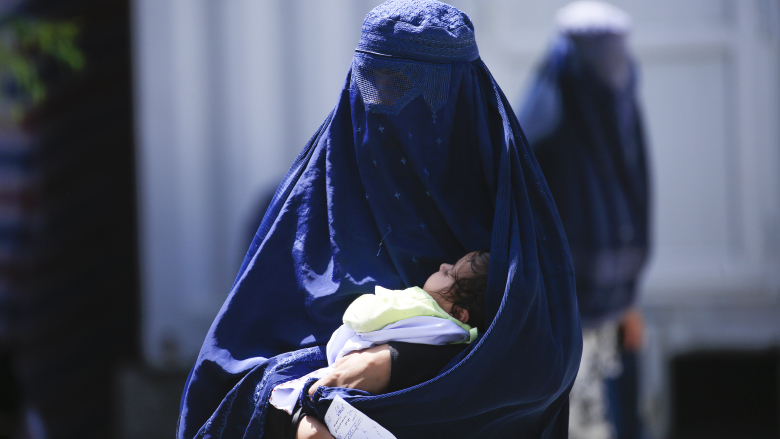
Story Highlights:
- Residents of a rural district in Afghanistan's Kabul province once sought health care far from their homes as local facilities were understaffed and poorly resourced.
- A government health project, the System Enhancement for Health Action in Transition (SEHAT) program, has been instrumental in rehabilitating health services in the district, bringing health care closer to the residents.
- SEHAT’s successor, Sehatmandi, is building on these efforts to increase the utilization and quality of health, nutrition, and family planning services across the country.
MIRBACHAKOT DISTRICT, Kabul Province – Several women and their children gather under a shady tree as they wait to see the doctor at a Basic Health Center (BHC). A health care professional greets the women and gives a short overview of the BHC procedures, as well as relevant information about its services.
Many of the women have come to the center for vaccinations, especially for their children. This has not always been the case, says a vaccinator in Mirbachakot district, about 35 km from Afghanistan’s capital, Kabul.
“Previously, people didn’t have a lot of information about vaccinations. Most of them believed in false rumors, such as vaccinations were not necessary or even harmful,” she says. “We raised awareness of those who knew little about immunization, were afraid to undergo vaccination or had a negative view about vaccines. Now those people have realized the importance of immunization and they regularly come here to take their shots.”
According to the district hospital officials, thousands of women and children in Mirbachakot district received vaccinations against tetanus, measles, tuberculosis, and a myriad of other preventable diseases at the health facilities under the System Enhancement for Health Action in Transition (SEHAT) project, implemented across the country from July 2015 through June 2018.
"We have more professional doctors and quality medicine that we can easily access. Our family’s life has become better and we are happy that health services are here."
- a resident of Kabul Province
Basic and Essential Health Services
The Sehatmandi project followed SEHAT with the aim of increasing the utilization and quality of health, nutrition and family planning services across the country . Building on the model and successes of the earlier project, Sehatmandi continues to provide two tiers of health services across the country, a Basic Package of Health Services (BPHS) and an Essential Package of Hospital Services (EPHS).
The projects provided support to rehabilitate Mirbachakot district’s health facilities, which had been underfunded, understaffed, and poorly resourced. A total of 42 rehabilitated BHC facilities provide BPHS, to the district’s 35,000 residents. Each station serves 100-150 families with services including vaccinations, maternal health care, and nutrition.
More complicated procedures and serious illnesses are referred to the three district hospitals offering services including general surgery, internal medicine, pediatrics, obstetrics and gynecology, dentistry, and treatment of contagious diseases like tuberculosis.
The district hospitals now operate 24 hours a day and run an ambulance service.
The health services have been well-received by residents, according to Dr. Ikram (name changed) at the district hospital. “The goal was to encourage each person to receive health services twice a year for general health based on the recommendations of the MoPH,” says Dr. Ikram, “but the new health services [BPHS and EPHS] have already surpassed this benchmark, and residents visit the health facilities at an average rate of 2.2 times per year.”
Like SEHAT, Sehatmandi is supported by the Afghanistan Reconstruction Trust Fund (ARTF), managed by the World Bank on behalf of 34 donors, and the International Development Association (IDA), the World Bank fund for the poorest countries. Sehatmandi also receives support from the Global Financing Facility, a multi-stakeholder partnership prioritizing high impact but underinvested areas of health.
Life-saving Services
For women like Dunia (name changed), 30, a Mirbachakot resident, the health services provided in the district health facilities could be life-saving in a country with one of the highest maternal mortality ratios in the world. The birth of her first child was difficult and complicated, and she had to seek medical help in Kabul city because of the lack of facilities in the district then.
Dunia now takes advantage of the maternal health services at the closest district hospital. “After the rehabilitation of this hospital, we have many facilities that we are really satisfied with and we also like how the hospital staff cares for us and behaves professionally,” she says.
Mohammad (name changed) a shopkeeper in Mirbachakot, is equally happy that there are now health facilities closer to his home as his wife and daughter suffer from chronic illnesses that require frequent treatment. Health services are now five minutes away by car, compared to the long distance they had to travel previously.
“Now we have more professional doctors and quality medicine that we can easily access,” Mohammad says. “Our family’s life has become better and we are happy health services are here. My daughter has gotten better from the first time we brought her here.”